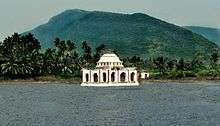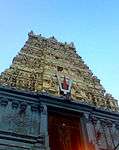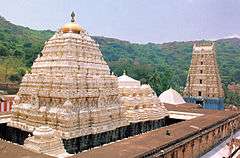Simhachalam Temple
| Simhachalam Temple | |
|---|---|
|
Simhachalam Temple | |
 Simhachalam Temple Location in Andhra Pradesh | |
| Geography | |
| Coordinates | 17°45′59″N 83°15′02″E / 17.7664°N 83.2505°ECoordinates: 17°45′59″N 83°15′02″E / 17.7664°N 83.2505°E |
| Country | India |
| State/province | Andhra Pradesh |
| Locale | Visakhapatnam |
| Culture | |
| Primary deity | Vishnu, Narasimha |
| Architecture | |
| Architectural styles | Kalinga Architecture, South Indian |
| History and governance | |
| Website | http://simhachalamdevasthanam.net/ |
Simhadri or Simhachalam is a Hindu temple located in Visakhapatnam city suburb of Simhachalam in Andhra Pradesh, India. It is dedicated to Lord Narasimha (the man-lion), an incarnation (avatar) of Lord Vishnu. The central shrine was built in Kalinga architectural style.
Description


"Simha" in Sanskrit means lion; "Adri" or "Achala" in Sanskrit means hill. The temple is located at the top of a hill; hence the temple is called Simhachalam. Sri Varahalakshmi Narasimha Swamy, the lion-man incarnation of Lord Vishnu, is the presiding deity of the temple. The temple is one of the eighteen "Narasimha Kshetras", the shrines of Lord Narasimha, in India. The deity is usually covered with sandalwood paste year round and can be seen without sandalwood ("nijaroopa darshan" – holy appearance in true form) for only 12 hours per year.[1] On Akshaya Tritiya Day, the deity is re-covered with sandalwood paste. The festival of 'Chandana yatra' or 'Chandanotsavam' falls every year in Vaisakha (May).
The deity is in the tribhangi posture, with two hands and the head of a lion on a human torso. An inscription dated 1098 AD of the Chola King Kuloththunga provides a clue as to its antiquity. Another inscription names a queen of the Eastern Ganga of Kalinga (ancient Odisha) (1137–1156), while a third inscription says the eastern Ganga King of Odisha, Narasimhadeva II (1279–1306), built the central shrine in 1267. More than 252 inscriptions in Odia and Telugu describe the antecedents of the temple.
Sri Krishna Deva Raya visited the shrine in 1516 and 1519. He offered numerous valuable jewellery, of which an emerald necklace is still in the temple. For the last three centuries the royal family of Vizianagaram, the Pusapati Gajapathis, have been the temple's trustees.The last King of Vizianagaram Dr.PVG Raju Garu donated Lakhs of acres of land to Simhachalam Devastanam.
Geography

The Simhachalam temple faces west. According to religious belief, an east-facing entrance brings prosperity, while a west-facing one brings victory. The temple is situated among hills covered with cashew trees, shrubs, and mango groves. Many pilgrims undertake Giripradhikshana (circumambulation) of the hill on auspicious days. Neighbourhoods near the pilgrimage include Srinivasanagar, Prahladapuram, Sainagar colony, Simhapuri colony, and Simhapuri Layout. The journey often extends into the night, as the route is around 40 kilometres (25 mi). Pilgrims then visit the temple to give offerings to the deity.
Legends
Hiranyakasipu was a Rakshasa king and a reincarnation of one of Vishnu's Dwarapalakas (gatekeepers) in Vaikuntha (heaven). The other palaka was born as his brother Hiranyaaksha. The gatekeepers, Jaya and Vijaya, were cursed by Sanaka, Sanandana, Sanathkumara, and Sanathsujatha because the gatekeepers did not allow these four to take darshan of Mahavishnu. As a result, the gatekeepers were reincarnated three times. Hiranyakasipu decided to perform austerities (tapasya) to appease Lord Brahma, which would allow him to become immortal. However, Lord Brahma said that it was not possible.then brahma give a boon to hiranyakashaka that was if anybody try to kill you they must be want to kill you without placing on land.so it must become secret.that's why he become so dare anybody never kill him.
Hiranyakasipu's son Prahlada was a devotee of Lord Narayana and always expressed his devotion (bhakti) towards him. Hiranyakasipu could not alter Prahlada's devotion and became infuriated. He made several attempts to have Prahlada killed, including throwing him off a mountain top,putting him in a chamber of snakes and throwing him into a cage of a hungry tiger. Vishnu rescued Prahlada by moving the mountain and creating a small path,burning up the snakes and vanished the tiger . As the avatar Lord Narayana, Vishnu came to rescue Prahlada. When Lord Narayana jumped to save Prahlada, his feet sunk deep into the earth.Therefore, the god's feet are not shown anywhere at the temple, as it is said that his feet are buried in the earth. The legend says that the Simhachalam temple was built on the exact spot where Vishnu stood to protect Prahlada.
A second legend says that when the Muslims were about to destroy and plunder the temple during an invasion, a poet named Kurmanatha implored Lord Varaha Narasimha to save the temple and the Hindus. In response to these prayers, a huge swarm of copper hornets suddenly appeared and attacked the invading army, driving them out of the city. The swarm then disappeared behind a hillock now known as Tummedala Metta (Tummedala: of hornet; Metta: hillock).
Transport
Walking: By walking you can reach the temple, which is 1.1 kilometers distance.
Road: Simhachalam can be accessed by road from Simhachalam Bus Depot by APSRTC city buses, which is 4.4 kilometers, or by Simhachalam Temple Bus Service. APSRTC operates frequent buses from Dwaraka RTC complex in Visakhapatnam city which is 19.9 kilometers to SimhachalamTemple.
Rail:- The nearest railway station is at Simhachalam , about 11.1 kilometres from Simhachalam Temple.Visakhapatnam railway station is the main station which is about 18.5 kilometers.
Airport: The nearest airport is Visakhapatnam Airport, about 13.2 kilometres from Simhachalam. It operates daily flights to Hyderabad, New Delhi, Chennai, Banglore, Mumbai, Kolkata, Bhubaneswar, Tirupati, and Port Blair. It also has international connectivity with Dubai via Hyderabad, Singapore, Kuala Lampur.
Gallery
-

Stone throne behind the temple
-

Exit to the temple
-

Parking lot opposite the Gopuram
-

The long hike towards Simhachalam
-

Mandapa constructed in 2010
-

Temple exit
-

Wooden chariot at the temple
See also
- Sri Simhachala Kshetra Mahima, 1965 Telugu film
References
| Wikimedia Commons has media related to Simhachalam Varaha Narasimha Temple. |
- ↑ "Simhachalam". Retrieved 6 August 2013.
- Web page
- Information at www.simhachalam.com
- Simhachalam Information at www.templenet.com
- Information at www.go2india.in
- Information at www.my-telugu.com
| |||||||||||||||||||||||||||||
| ||||||||||||
| ||||||||||||||||||||||||||||||||||||||||||||||||||||||||
| ||||||||||


